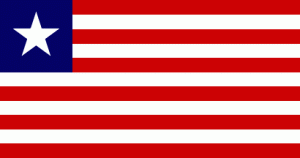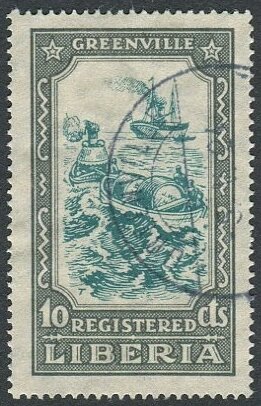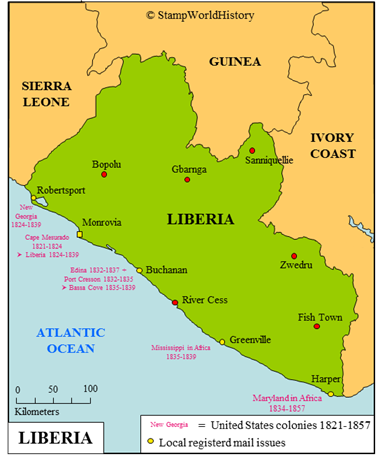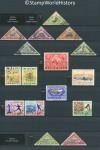
Liberia
Quick reference
General issues: Republic 1860-Present
Special issues: Local registration issues Buchanan, Greenville, Harper, Monrovia, Robertsport 1893-1924
Country name on general issues: Liberia
Currency: 1 Dollar = 100 Cents 1860-Present
Population: 641 000 in 1900, 4 195 000 in 2015
Political history Liberia
Scattered colonies form a republic
Liberia is located in western Africa. The indigenous population consists of a range of different Niger-Congo peoples. The first European traders to set up trade posts in the future Liberia were the Portuguese in the late 15th century – other European nations to follow in subsequent years, none establishing a permanent presence.
From the 1820’s, a number of United States societies establish a total of six colonies on the Liberian coast with the goal to resettle freed slaves and their descendants from the United States. There were rather opposite motives behind this resettlement policy. On the one hand, abolitionists considered a future in Africa to be a better one for freed slaves than could be expected in the United States. On the other hand, slaveholders and segregationists considered resettlement in Africa a means of getting freed slaves out of the way. The first colony was established in 1821 by the American Colonization Society – a colony that, from 1824, would be called Liberia. Five more colonies were set up by similar societies in the 1820’s and 1830’s. Aside from freed slaves from the United States, slaves from the Caribbean and from captured slave ships would settle in these colonies – groups that would blend to form the Americo-Liberians. In 1839, four of the five still existing colonies joined to form the commonwealth of Liberia. In 1847, Liberia proclaimed its independence as the republic of Liberia. The fifth colony joined Liberia in 1857. Independence of Liberia was recognized by the United States in 1862. The borders were established through treaties with Britain – Sierra Leone – in 1885 and 1903 and with France – Guinea and Ivory Coast – in 1892.

United Nations peacekeeping force in Liberia – United Nations Mission in Liberia – UNMIL
Americo-Liberian dominance in politics
The Americo-Liberians – less than 5% of the population – formed a top layer in Liberian society that was largely segregated from the indigenous peoples. These indigenous peoples would revolt repeatedly against the political and economical predominance of the Americo-Liberians. Although changes aimed at integration of the indigenous peoples were effected in the 1950’s and 1960’s, the Americo-Liberians dominated Liberian politics until 1980, when, through a coup d’etat, the reigning Americo-Liberian president was ousted.
Recent history
The change of power did not bring Liberia political stability. From 1989 to 1996, and again from 1999 to 2003, the country has been engulfed by civil war. A war that spilled over the borders, as Liberian factions also played a substantial part in the civil war that raged in neighboring Sierra Leone from 1991 to 2002. After a peace agreement in 2003, the United Nations has supported Liberia in order to regain political stability by forming a transitional government and organizing democratic presidential elections in 2005. In 2015, the United Nations passed a resolution to halve its presence in Liberia.
Economically, Liberia has known a period of significant growth between the 1940’s and the 1970’s – in the 1970’s Liberia was the largest rubber exporter in the world. Since the 1980 regime change, and the civil war in subsequent years, the Liberian economy has decreased in size dramatically. Currently, Liberia, in terms of per capita GDP, ranks 225 out of 230 countries in the world.
Postal history Liberia

1924 – Registration stamp for use in Greenville. Transporting merchandise from shore to ship, Reichsdruckerei Berlin
The first stamps are issued by Liberia in 1860. In the classical era, Liberia put stamp production into the hands of first British printers, then in the 1920’s German and from the late 1920’s American printers. Renowned printing houses such as Waterlow & Sons Ltd. and Perkins Bacon Ltd. in London and the Reichsdruckerei in Berlin have provided attractive engraved stamps. The stamps printed by the American Bank Note Co., and other United States printers, show similarity with contemporary United States issues. Issues from the classical era that have genuine postmarks have a significantly higher value as many stamps have been cancelled to order or have fake cancels. For an inspired and in depth presentation of the issues from the classical era please refer to the pages on Liberia in the Big Blue 1840-1940 blog – Liberia 1860-1914 and Liberia 1915-1940.
Between 1893 and 1924, Liberia has issued registration stamps for local use in the main cities in the country: Buchanan, Greenville, Harper, Monrovia and Robertsport – recognized easily as these stamps are inscribed with the names of the cities.
In the modern era, Liberia has issued a mix of stamps with both themes of a national interest and themes of interest mainly for the thematic collectors market.
Album pages
← Previous page: LesothoNext page: Libya →



